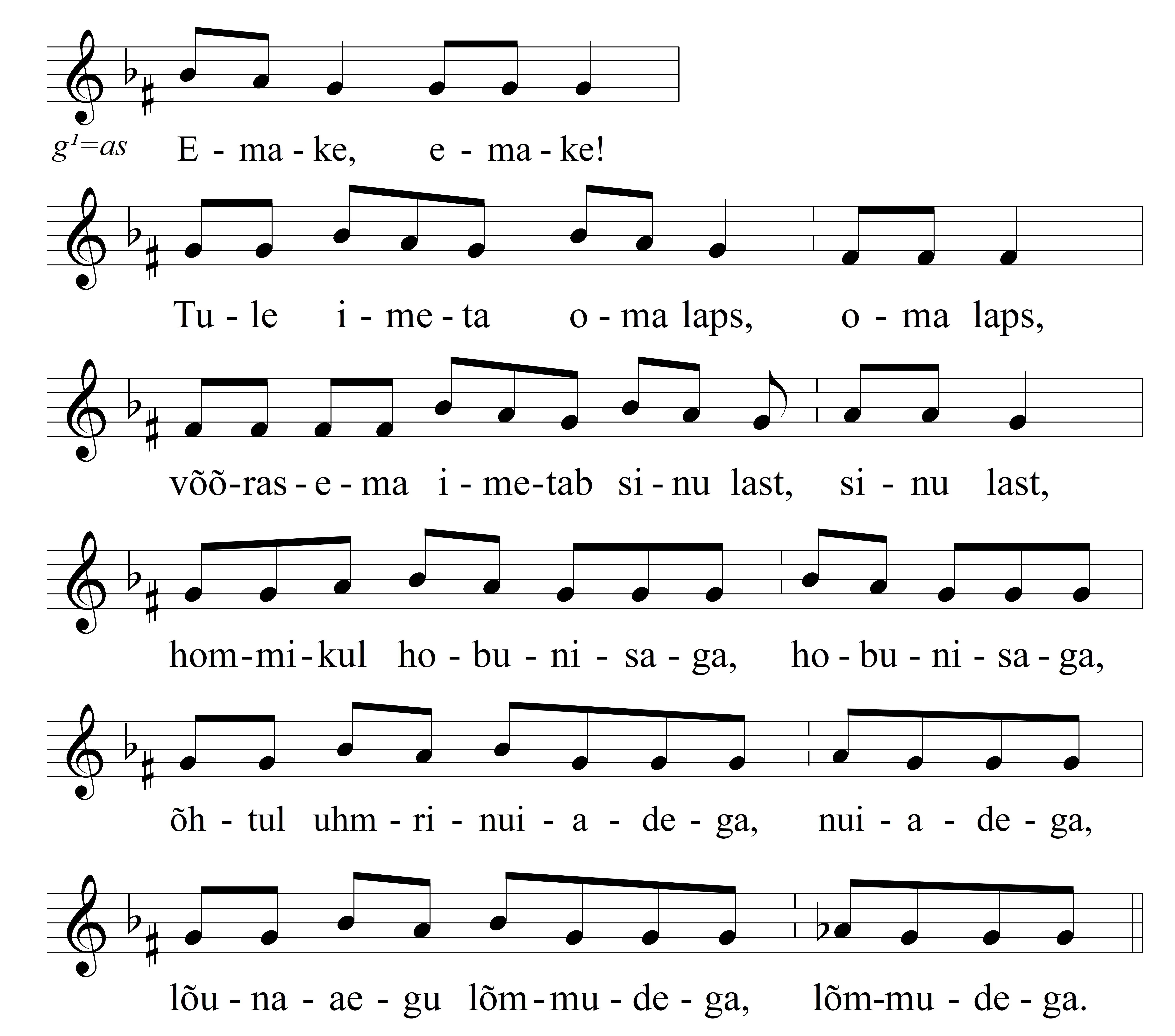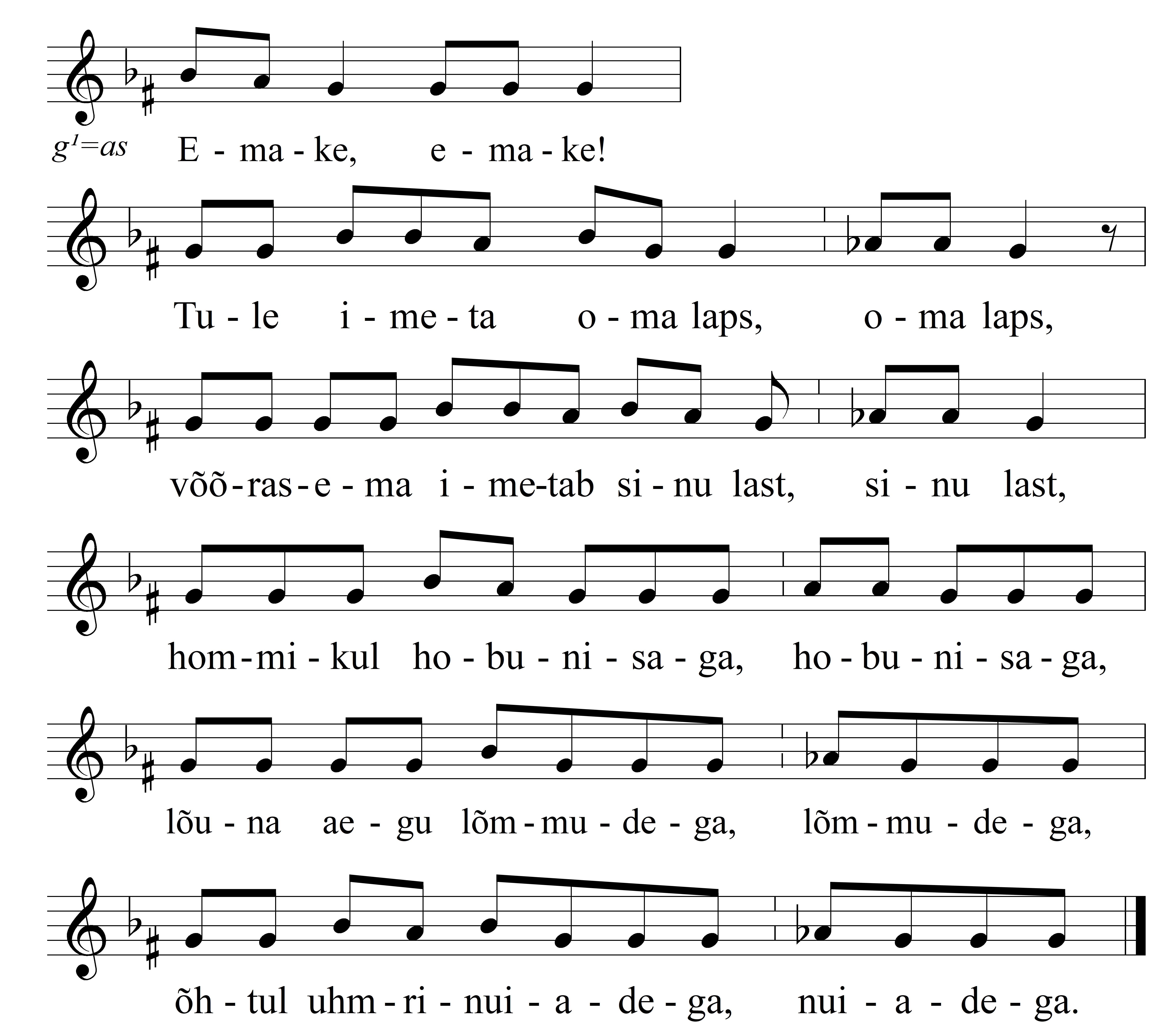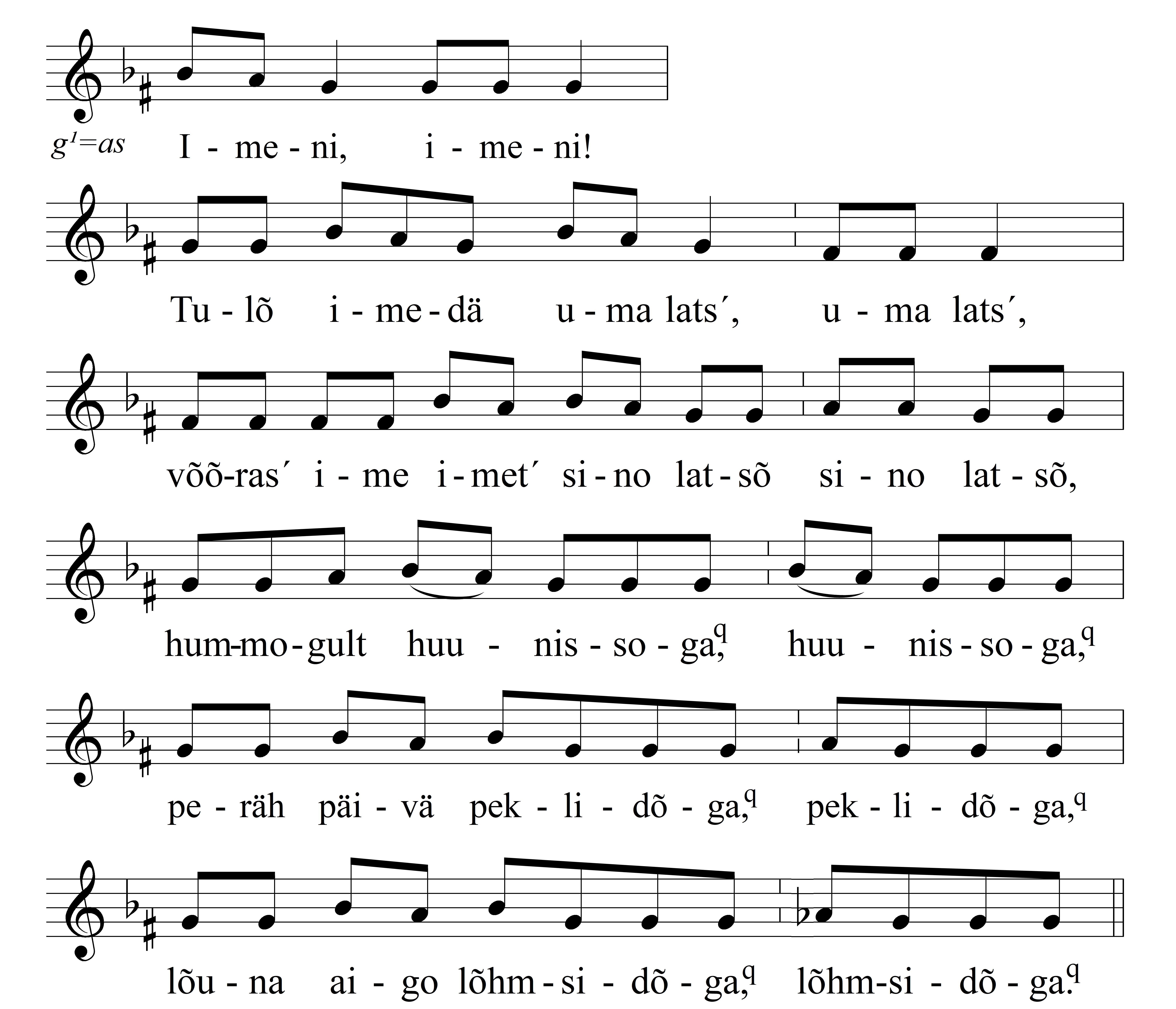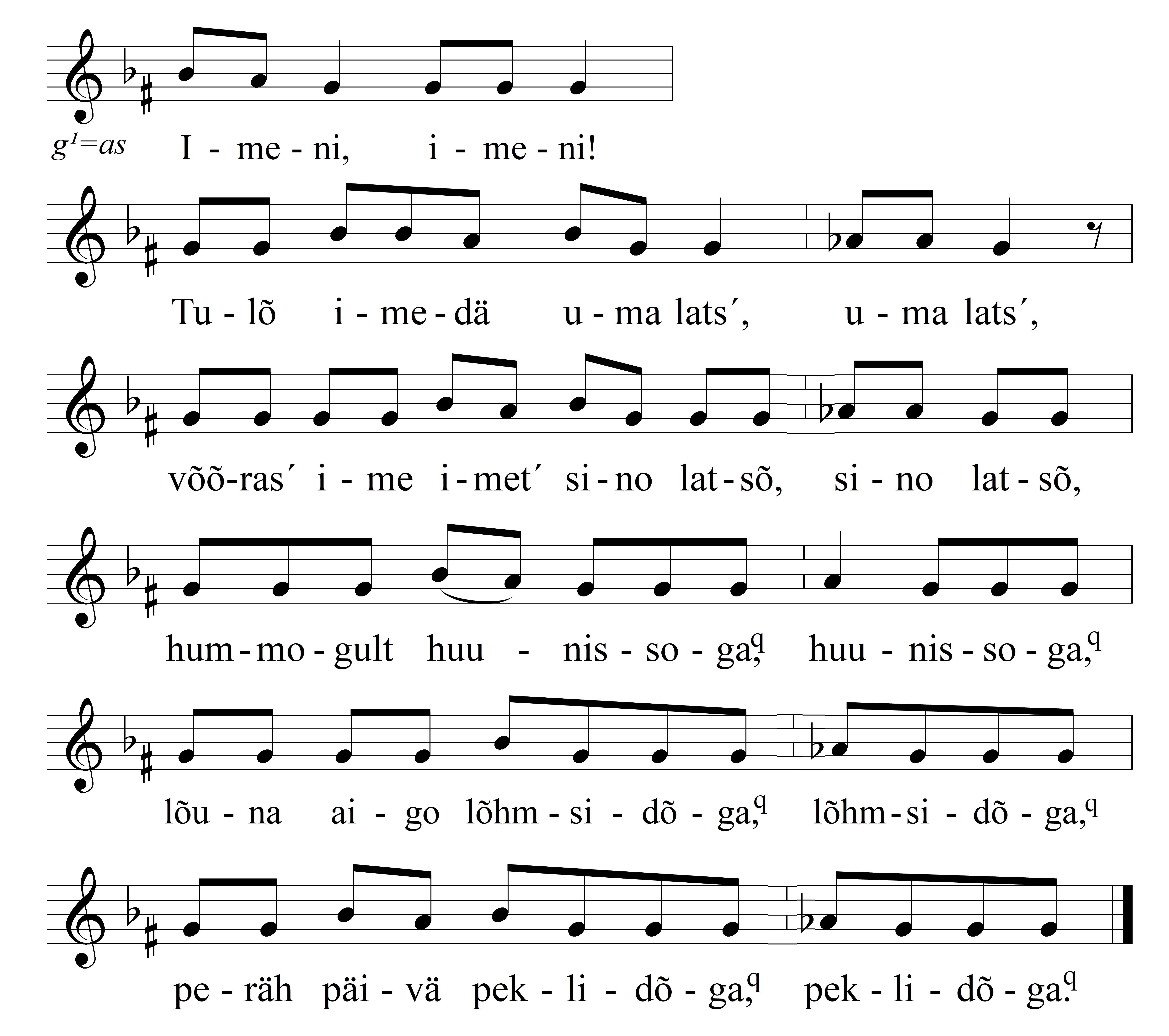Animals
She was an orphan girl and a suitor came to their place. She wanted him, but her mother, or actually her stepmother, mocked her and didn’t want him, of course… However, the suitor somehow succeeded to steal the desired girl.
And so the orphan started to live with this man, the suitor, and a child was born, was it a boy or a girl. The stepmother went there to the christening with her own daughter, and somehow the stepmother turned her stepdaughter into a wolf, replacing her with her own daughter. The wolf escaped. And the stepmother said: „You see, what a tramp! Look how she has left…“ [---] The child remained to be brought up by the daughter of this [evil stepmother]. But she herself left for the forest.
The father also had a servant, a babysitter. But the child was very restless. The daughter – and false mother – suckled the child but the breast was what it was. And the child didn’t stay long at her breast. The babysitter took the child on her lap and she understood everything; she realised that the daughter was not the real mother, and so she went to the forest and sang like this:
Mummy, mummy!
Come suckle your child!
The stepmother suckles your child,
By horse teats in the morning,
by mortar pestles in the evening,
by dry pine logs in the noon.1
And then the orphan – mother – came! In the old days it was said that she was wearing tar skin or wolf skin and that she threw it off. And she suckled the child and gave it back; she took her skin and went back to the forest.
But again the child didn’t stay at the breast of this devil on the second day. How could the baby accept this! So, the babysitter took the child again to the forest. But the man was also there and heard the babysitter… or he noticed that the babysitter went there with the child and sang again like this:
Mummy, mummy!
Come suckle your child!
The stepmother suckles your child,
By horse teats in the morning,
by dry pine logs in the noon,
by mortar pestles in the evening,
Yes, again the mother gave the child back to the babysitter. She herself pulled on the wolf skin and went back to the forest. The babysitter went home with the child.
The man then went to a sage, or witch. The latter instructed him: „Find out where she goes with the child and heat up a stone already there. See where she throws that wolf skin, and heat the stone up very, very well. When she throws off the skin and it catches fire, and she tries to escape, catch her and don’t let her go! Whatever she does don’t let her go! Finally, when she turns herself into a spindle, break it. Wrap it into a shawl and take it to the bed, and you will have your wife back.“
And this is what he did. He heated up a stone. The babysitter was singing there, and the mother came there again. He threw the skin on the stone and it caught fire. The mother wanted to escape but the man grabbed her and didn’t let her go. She turned herself into everything! The man was scared but he still didn’t let her go. Finally, she turned herself into a spindle. He broke it, wrapped it into a shawl and took it home. It became his wife again.
But the evil stepmother's daughter… I don’t remember what happened to her, or how she got killed. Maybe stones were brought to her and were placed in such a way that she died. And the man started to live with his wife again.
1There were special logs in the household, to be cut into splinters. In the comments of the other variants of the same fairy tale it has been said that the stepmother tried to make breasts out of birch bark or wood pieces.
Ta oli vaeslaps, ja sinna tuli kosilane. Tüdruk tahtis teda, aga ema, see tähendab võõrasema, siis muidugi pilkas teda ega tahtnud… Aga mees kuidagi varastas ta.
Ta hakkas selle mehega koos elama. Ja tal sündis ka laps, oli siis poisike või tütarlaps. Võõrasema läks oma tütrega sinna ristsetele. Ja võõrasema muutis ta kuidagi hundiks ja pani oma tütre sinna asemele. Ta põgenes ära, see hunt. Eks siis võõrasema ütleski et: „Näed, oli selline hulgus ja nõnda ta läkski…“ --- Lapseke jäi selle vanapagana [võõrasema] tütre kasvatada. Aga naine läks ära metsa.
Sel mehel oli võetud ka teenija, lapsehoidja. Aga lapseke oli väga püsimatu. Ta [vale ema] andis talle küll rinda mis ta andis, selline nagu see tema rind oligi. Aga laps ei püsinud rinna otsas. See hoidja võttis lapsekese sülle ja – ta teadis kõike, sai aru, et see pole õige ema – ja läks metsa äärde ja laulis seal:

Ja siis ta tuligi. Vanasti üteldi, tõrvanahk või hundinahk, mis tal seljas oli, selle viskas maha. Ja imetas lapse ära ja andis tagasi; võttis oma naha ja läks tagasi metsa.
Nõnda lapsekene teine päev jälle ei püsinud selle vanapagana rinna otsas. Kuidas ta saakski sellega leppida. Niisiis, lapsehoidja viis lapsekese jälle metsa äärde. Aga mees käis ka seal ja kuulis, et hoidja… või märkas, et hoidja läks lapsekesega sinna ja laulis nii:

Jah, [ema] andis siis lapse uuesti hoidja sülle. Ise tõmbas hundinaha selga, või soenaha, ja läks tagasi metsa. Hoidja läks lapsega koju.
Siis läks mees targa või nõia juurde. See õpetas: „Uuri järele, kuhu ta lapsega läheb, ja aja seal juba enne kivi kuumaks, uuri kuskohta ta täpselt selle naha viskab, ja aja seal kivi hästi, hästi kuumaks. Kui ta selle naha maha viskab ja nahk ära põleb ja ta tahab põgeneda, sa võta ta kinni ja ära lase enam lahti, ükspuha mis ta ka ei teeks, aga ära teda lahti lase. Aga lõpuks, kui ta moondab ennast kedervarreks, siis murra see katki, pane räti sisse ja vii voodisse, siis saad oma naise jälle tagasi.
Ja nii ta tegigi, ajas kivi kuumaks, lapsehoidja laulis seal – ja see tuli jälle. Viskas naha sinna kivi peale ja nahk läks põlema. Ta tahtis põgeneda, aga mees võttis ta kinni ega lasknud enam lahti. Ta moondas ennast kõigeks – mehel on küll hirm, aga lahti ka ei lase. Kõige lõpuks tegi ta end kedervarreks, mees murdis selle katki, pani räti sisse ja viis koju. Sellest sai uuesti naine.
Aga see vanapagana tütar, ma ei mäleta, mis temaga juhtus, kuidas ta surma sai. Kas toodi talle kive ja pandi nii, et ta sai surma. Ja mees hakkas jälle oma naisega elama.



